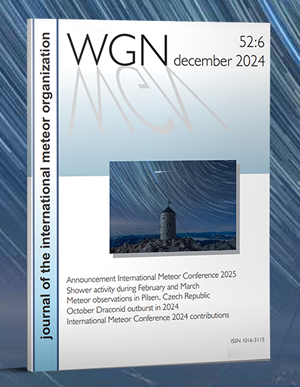During this period the moon reaches its last quarter phase on Friday April 13th.
At that time the moon will be located ninety degrees west of the sun and will
rise near 0200 daylight saving time (DST) for observers situated in the
mid-northern latitudes. This weekend the waning gibbous moon will rise during
the early evening hours, effectively ruining the sky for nearly the entire
night. This week is the worst time to try and view meteor activity during the
month. Conditions will improve when the moon reaches its last quarter phase and
continues to wane toward new. The estimated total hourly rates for evening
observers this week is near one for observers in the northern hemisphere and two
for those south of the equator. For morning observers the estimated total hourly
rates should be near three as seen from mid-northern latitudes and six from
mid-southern latitudes. The actual rates will also depend on factors such as
personal light and motion perception, local weather conditions, alertness and
experience in watching meteor activity. Rates are reduced
during this period due to severe moonlight.
The radiant (the area of the sky where meteors appear
to shoot from) positions and rates listed below are exact for Saturday night/Sunday
morning April 7/8. These positions do not change greatly day to day so the listed
coordinates may be used during this entire period. Most star atlases (available
at science stores and planetariums) will provide maps with grid lines of the
celestial coordinates so that you may find out exactly where these positions are
located in the sky. A planisphere or computer planetarium program is also useful
in showing the sky at any time of night on any date of the year. Activity from
each radiant is best seen when it is positioned highest in the sky, either due
north or south along the meridian, depending on your latitude. It must be
remembered that meteor activity is rarely seen at the radiant position. Rather
they shoot outwards from the radiant so it is best to center your field of view
so that the radiant lies at the edge and not the center.
Viewing there will allow you to easily trace the path of each meteor back to
the radiant (if it is a shower member) or in another direction if it is a
sporadic. Meteor activity is not seen from radiants that are located below the
horizon. The positions below are listed in a west to east manner in order of
right ascension (celestial longitude). The positions listed first are located
further west therefore are accessible earlier in the night while those listed
further down the list rise later in the night.
The table below presents a condensed version of the expected activity this week.
Rates and positions are exact for Saturday night/Sunday morning. Descriptions of
each shower will return next week when the moonlight situation improves.
| SHOWER | DATE OF MAXIMUM ACTIVITY | CELESTIAL POSITION | ENTRY VELOCITY | CULMINATION | HOURLY RATE | CLASS |
| RA (RA in Deg.) DEC | Km/Sec | Local Standard Time | North-South | |||
| Antihelions (ANT) | – | 14:04 (211) -12 | 30 | 02:00 | 1 – 1 | II |
| Zeta Cygnids (ZCY) | Apr 06 | 20:04 (301) +41 | 44 | 10:00 | <1 - <1 | IV |




 You saw something bright and fast? Like a huge shooting star? Report it: it may be a fireball.
You saw something bright and fast? Like a huge shooting star? Report it: it may be a fireball.  You counted meteors last night? Share your results with us!
You counted meteors last night? Share your results with us!  You took a photo of a meteor or fireball? You have a screenshot of your cam? Share it with us!
You took a photo of a meteor or fireball? You have a screenshot of your cam? Share it with us!  You caught a meteor or fireball on video? Share your video with us!
You caught a meteor or fireball on video? Share your video with us!